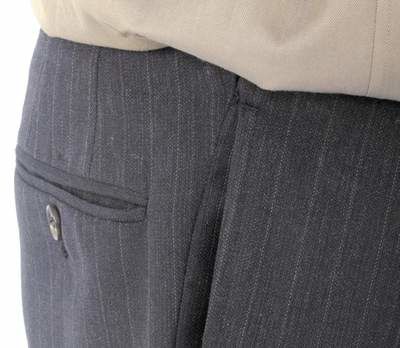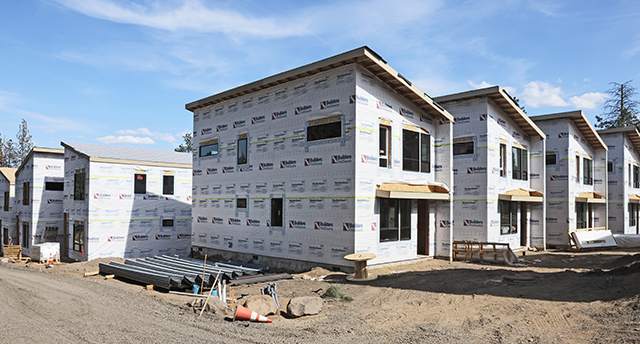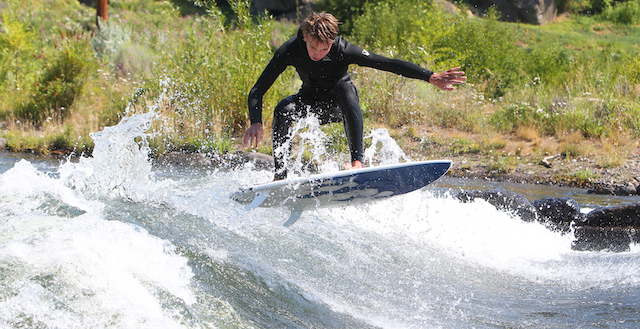The right fit
Published 5:00 am Wednesday, March 11, 2009

- The right fit
In the land of fashion faux pas, the problem of fit plagues more consumers than many realize, according to stylists with a view into consumers’ closets.
“I would say 95 percent of people wear things that are too big,” said Joanna Van Vleck, founder of The Trunk Club, a high-end men’s styling and personal shopping company based in Bend.
Maybe it’s because we grew up buying clothes we’ll “grow in to,” Van Vleck said. Or maybe our perception of what size we wear, or what style looks best on us, is a little off.
Whether your slacks give you a high-water effect or your sweater shoulder seams fall halfway down your arm, local stylists offer easy and generic ways to tell you how to find that perfect fit.
First, Van Vleck advises against shopping by size.
“Whatever size you think you are, forget that,” she said. “Try on two to three different sizes and find one that fits best.”
Additionally, shoppers should always, always try clothes on before buying. One store’s small is another store’s medium.
Men
On Van Vleck’s Web site, www.trunkclub.com, she outlines do’s and don’t for men’s clothing — when wearing a suit, the belt and shoes should match; pleated pants are bad because they add extra weight to your physique, etc. The rules are for people who need help in the style department, but finding the perfect fit isn’t just for the fashion-clueless.
Van Vleck offers some guidelines for men’s clothes:
• Shirts — All shoulder seams should hit at the shoulder’s natural break, where the shoulder meets the arm. Tommy Bahama’s resort-style floral shirts have the shoulder seam halfway down the arm, a style of fit that is the exception to the rule. Otherwise, even casual shirts — whether cotton tees or button-up collared shirts — should have a shoulder that fits at your natural bend.
“If the shoulder seam hits you in the right place, (the shirt) is most likely going to fit you everywhere else,” Van Vleck said, adding that the same rule can be applied to jackets.
Sleeves should be long enough to barely show under the sleeve of your suit jacket, with the shirt cuff ending at the wrist bone.
• Suit jackets — In addition to shoulders that fit, the arms have to be short enough that the long-sleeved shirt underneath shows one-eighth to one-quarter of an inch of fabric at the cuff. That adds just a little splash of color to the outfit.
“A lot of people put on suit jackets and think (the arms) are too short,” Van Vleck said. “But you want them to be a smidge on the short side.”
The bottom of the jacket should fall just below the buttocks — any longer and it will make you look shorter.
Finally, the collar of the jacket should not stand away from, or conceal, the shirt collar.
• Pants — Depending on trends, the waist can vary from low-rise to medium and high-rise. Mid- to low-rise waists are the most flattering on the most people, Van Vleck says, because high-waisted pants create the illusion of a larger, taller rear end. Pockets should lie flat, not gape open.
For length, all pants should have a one-inch break at the bottom, where the pants hit the shoe. That means you’ll see one crease over the shoe.
“One tip: if you have to have pants altered, put your shoes on when you’re being fitted,” Van Vleck said. “Even for men’s shoes, there’s a little heel, so make sure you pick a size that fits with the shoe you’ll wear with the pants.”
Women
Barbara Dolezal is a stylist and closet organizer who works with primarily women in the Bend area.
Most of women’s clothing is sized by numbers, instead of by inch count, which makes finding a good fit across brands even more difficult.
To help women know what to look for in the dressing room, Dolezal has some guidelines:
• Shirts — Long sleeves should fall on the wrist bones, with the sleeve hanging vertically from the point where the arm joins the shoulder.
All front buttons should fasten smoothly, with no gaping.
Collars should rest flat against the back of the neck and darts shouldn’t pucker. Darts are the tapered seam of fabric used for adjusting the fit of a garment, as you see on the back of shirts and around the bust.
Bustline darts should end at the fullest part of the bust, with fabric smooth across the bust, lower torso, backside and hips.
The blouse shouldn’t balloon over the waistband and tails of shirts should be easily tucked in.
• Jackets — You should be able to comfortably stretch your hands above your head and out to the side. When you put your arms down again, the jacket should fall back into place. Shoulder pads, if you have them, should rest snugly on top of the shoulders, not falling forward, back or down the arm.
The top button of the jacket must be able to fasten without straining the material, even if you don’t normally fasten it.
• Trousers and skirts — Both must be easy to slide on, without wiggling, and you should be able to fit two fingers in the waistband. You should also be able to sit and cross your legs without stressing the fabric.
Skirts should not twist around the waist when you walk and should allow you to take normal strides. The fabric should fall straight down the backside and shouldn’t cling to the buttocks.
Pockets should sit flat, with no gaping, and the zipper, buttons and other fastenings should not be strained.
Like men’s pants, standard trouser hems should skim the front of the shoes and fall one-quarter inch from the floor. Keep in mind the height of heels you’ll be wearing with the pants — shorter pants need flats or kitten heels, whereas longer pants should never drag on the ground — wear them with a heel.
Fit your body
Dolezal says women will have more success in shopping if they consider their body type.
Body types fall within a wide spectrum of shapes and sizes. While many of us might not fall exactly within the strict definition of a certain body type, we can look for clothes that tend to fit the body that best matches our own:
• Pear shaped — small on top, round on the bottom — Try dresses that are fitted on top and have an A-line skirt that falls to the knee. A-line skirts are fitted at the top and then fall slightly out from the body like the letter A.
Pear-shaped women should choose pants that are a trouser leg or boot-cut, Dolezal says. Skinny jeans, on the other hand, will make women like them look like an ice cream cone.
Shirts should not be fitted too tight, because it will make them look disproportionate, or too baggy, because they will look wide all over. Instead, try a brightly colored top with darker or neutral-tone pants or skirts that draw attention to the upper half.
• Apple shaped — round in the middle — Structured garments are best for this body type. Structured garments are fitted, but not clingy, and made of a stiffer material, such as cotton. They often have tapered seams to give the illusion of a fitted shirt.
Pants should be wide-leg or slightly flared to balance the midsection.
Dresses should have a defined waste and accentuate the bust, with an A-line or full skirt to give the illusion of a smaller, defined waist and more hourglass figure. Wrap dresses are very flattering for this body type, Dolezal added.
“Many people believe that wearing flowing or loose tops will camouflage the stomach,” Dolezal says, “but this actually makes you look heavier.
Instead, wear a top made with a heavier material in a tailored look that creates a defined waist: wrap tops, belted tops and tops with a waist seam.
Chiffon, satin and silk garments can be flattering if worn properly, Dolezal said. They should not be too billowy or loose, but also not too tight. They are best if belted or fitted. And, as is true for all lightweight fabrics, the proper bra is a must, so Dolezal recommends that everyone get professionally fitted — a free service at lingerie retailers.
• Hourglass shaped — curvy on the top and the bottom, with a small waist — Many styles look great on this body type, Dolezal said.
Avoid empire-waisted dresses (a high seam under the bust) that have too much fullness on the bottom because they can make you look pregnant.
Avoid loose clothing because it will make you look large and hide your waist, which is your thinnest area.
This body type should accentuate a small waist by wearing clothing that is fitted on top. V-neck shirts work well.
• Boy shaped or ruler shaped — small chest, small hips — This is one of the only body types that can wear baby-doll dresses without looking pregnant. Baby-doll dresses are super short and have high waists, if any waist seam at all.
Dresses and tops with a defined waist and that accentuate the bust are best because they create curves, Dolezal says.
Skinny pants look great on this slender frame.
Do no wear shift dresses because they will make you look shapeless and rectangular. Shift dresses hang loose from the shoulders and fall down with little definition at the waist.
Words from the wise
Dolezal and Van Vleck say many men and women have closets full of clothes that don’t fit them.
“The best thing to know, for men and women, is to only have clothes in your closet that fit you at the moment,” Van Vleck said. “You don’t want to grow into anything and (holding on to) your ‘skinny’ clothes is horrible.”
Dolezal’s advice to shoppers is to stick to what looks good on you, not what you think is trendy, because trends don’t look good on everyone (consider skinny jeans).
Also, don’t buy anything just because it is on sale, Dolezal says.
“My advice is to not look at price tags,” she said. “Look at the clothes, and if you like it without looking at the price, then it’s OK to go ahead and take a peek.”
Do you have tension wrinkles?
Tension wrinkles occur when you wear something too big and the material sags, or too small and the material stretches.
Generally, horizontal, taut wrinkles mean your garment is too small, whereas slack, vertical wrinkles mean your garment is too big.
Bend stylist Barbara Dolezal explains:
• If the wrinkles radiate horizontally from the bust or armpit, your garment is too small across the chest.
• If the taut wrinkles radiate from the sleeve, your garment is too tight in the sleeve.
• If the slack wrinkles run vertically down the arms, the garment it too big across the shoulders.
• If excess fabric appears at the side seams below the waistband, the garment is too big in the hips.
• If slack wrinkles form around the waistband, the garment is too big around the waist.
• If V-shaped wrinkles appear down your backside, the garment is too big across the backside.







